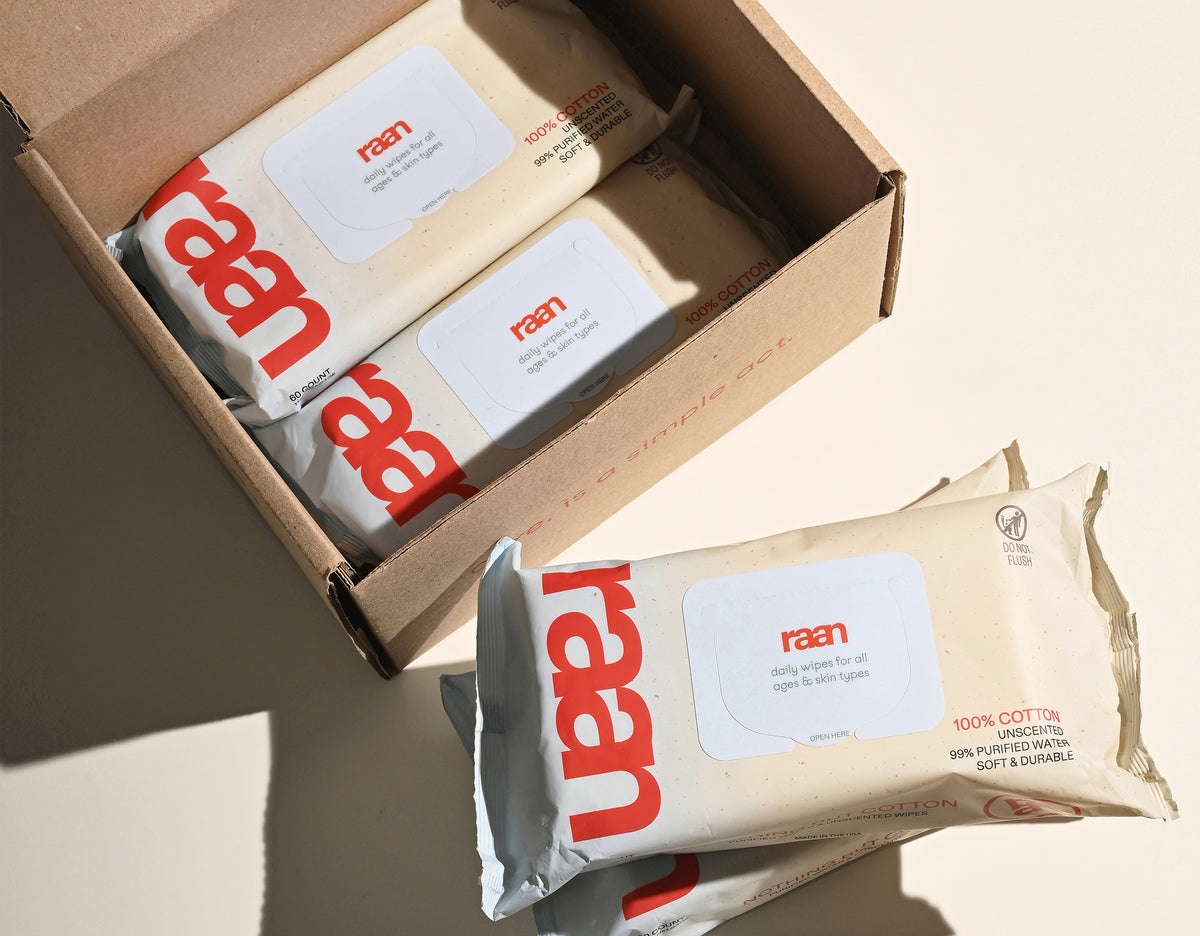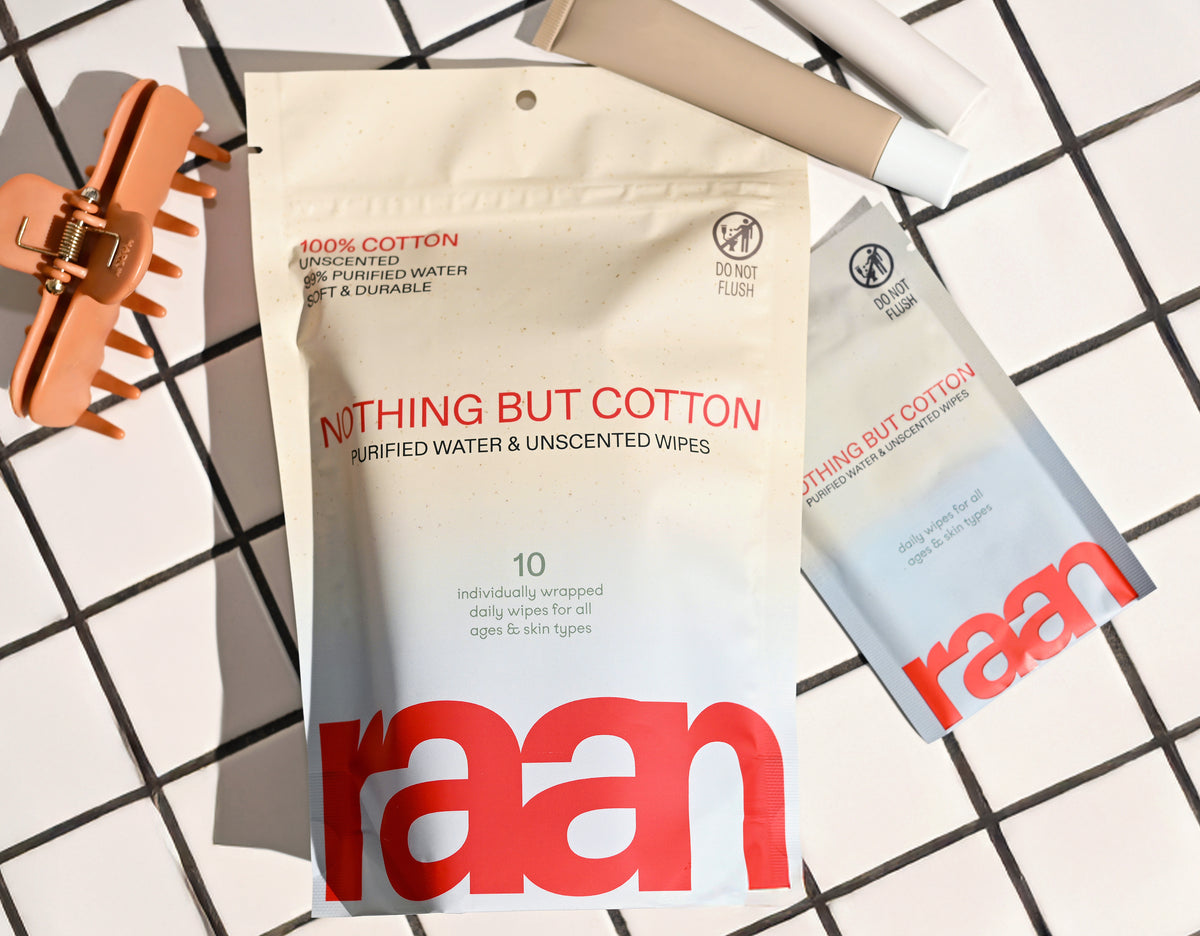Key Takeaways
- Newborn skin is about 30% thinner than adult skin, making it highly sensitive.
- Newborn skin absorbs substances faster and reacts more intensely than adult skin.
- Effective newborn skincare requires products that are both gentle and carefully formulated.
- Many baby care products contain synthetic preservatives and plastic fibers despite being labeled as "gentle."
- Parents should be cautious of ingredients they cannot recognize in newborn skincare products.
Table of Contents
- Keeping It Real with Newborn Skincare
- Meet Newborn Skin: Delicate By Design
- Why Soft Wipes Are a Skincare Essential (Not Just a "Nice-to-Have")
- Breaking Down the "Clean": What Sets Truly Gentle Wipes Apart
- Guide: How to Choose the Safest Soft Wipes for Newborn Skincare
- Decision Time: Soft Wipes vs. The Rest (Honest Comparisons)
- How-To: Using Soft Wipes Safely, Step-by-Step
- Addressing Everyday Worry Points
Keeping It Real with Newborn Skincare
Your newborn's skin is thinner than tissue paper, literally about 30% thinner than adult skin. It absorbs everything faster, reacts more intensely, and requires care that's as gentle as it is effective. Yet walk down any baby care aisle, and you'll find products packed with synthetic preservatives, plastic fibers, and ingredients you can't pronounce, all marketed as "gentle" and "safe."
The truth? Most conventional wipes contain hidden plastics and over a dozen additives that have no business touching delicate newborn skin. Soft wipes for newborn skincare aren't just about comfort, they're about choosing materials and formulations that respect your baby's developing skin barrier.
Real Talk: Newborn skin absorbs products up to five times faster than adult skin. What you wipe with matters more than you might think.
This guide cuts through the marketing noise to give you the facts about what makes wipes truly safe for newborns. We'll explore the science behind soft materials, decode ingredient lists, and help you navigate the overwhelming world of "clean" claims with confidence.
Meet Newborn Skin: Delicate By Design

Understanding why newborn skin needs special care starts with understanding how different it is from your own. Your baby's skin is still developing its protective barrier, a process that continues for the first year of life.
The Science Behind Newborn Sensitivity
Newborn skin has several unique characteristics that make it more vulnerable:
- Thinner epidermis: The outermost layer is significantly thinner, offering less protection against irritants.
- Higher absorption rate: Products penetrate deeper and faster into the bloodstream.
- Immature pH balance: The skin's natural acid mantle takes months to fully develop.
- Reduced sebum production: Less natural oil means the skin barrier is more fragile.
- Higher water content: Makes skin more prone to dryness when moisture is lost.
These factors explain why babies can develop rashes seemingly overnight or react to products that seem perfectly mild. Their skin simply doesn't have the same defensive capabilities as mature skin.
The skin barrier continues developing throughout the first 12 months. What you use during this critical period can either support or disrupt this natural process.
What's Normal (And What's Not)
New parents often worry about every spot, bump, or change in their baby's skin. Some common newborn features are completely normal:
- Vernix caseosa: The white, waxy coating that protects skin in the womb.
- Lanugo: Fine, downy hair that usually disappears within weeks.
- Milia: Tiny white bumps, especially around the nose.
- Newborn acne: Small red bumps caused by maternal hormones.
- Peeling skin: Especially common in overdue babies.
The key principle for all newborn skincare: less is more. Over-cleansing, over-moisturizing, or using products with multiple active ingredients can overwhelm developing skin.
Why Soft Wipes Are a Skincare Essential (Not Just a "Nice-to-Have")
When you're changing eight to twelve diapers a day, wiping tiny hands after every feeding, and cleaning up the inevitable spit-up, wipes become one of your most-used baby products. The texture, material, and formulation of those wipes can make the difference between healthy skin and constant irritation.
The Daily Reality: Mess Happens Fast and Everywhere
New parents quickly learn that babies are wonderfully, relentlessly messy. Diaper blowouts, spit-up, food experiments, and general stickiness are constants. You need wipes that can handle frequent use without compromising your baby's skin health.
This is where the concept of "soft" becomes crucial, and it's not just about how the wipe feels in your hand.
What makes a wipe truly "soft" for newborn skin? True softness comes from the material (unbleached, 100% cotton), the absence of rough synthetic fibers, and a gentle texture that won't create micro-tears in delicate skin.
What "Soft" Really Means in Wipe Terms
Not all soft wipes are created equal. Here's what separates genuinely gentle wipes from those that just feel soft:
- Material composition: Natural fibers like unbleached cotton versus synthetic blends or plastic-based materials.
- Fiber processing: Minimal processing preserves the natural softness and reduces chemical residues.
- Texture engineering: Smooth weaves that clean effectively without scraping or pulling at skin.
- Absence of hardening agents: No bleach, harsh processing chemicals, or synthetic strengtheners that can make fibers rough.
"The softest wipe for newborn skin is one that maintains its natural fiber integrity. When cotton is bleached or heavily processed, it loses its inherent gentleness," explains textile science research on natural fiber preservation.
For newborns, softness isn't luxury, it's necessity. Their skin can't tolerate the friction that older children and adults handle without issue. Every wipe interaction should feel like a gentle caress, not a scrub.
For more on the science behind cotton and newborn care, see our unbleached cotton guide.
Breaking Down the "Clean": What Sets Truly Gentle Wipes Apart

The baby wipe market is flooded with "gentle," "natural," and "sensitive" claims, but these terms aren't regulated. What actually makes a wipe safe for newborn skin comes down to specific, verifiable characteristics.
Key Characteristics of Safe, Gentle Wipes
When evaluating wipes for newborn skincare, look for these non-negotiable features:
- Unbleached, 100% cotton material: Natural cotton fibers are inherently hypoallergenic and biodegradable, with no synthetic additives.
- Fragrance-free formulation: Fragrances are among the most common allergens and have no functional purpose in baby wipes.
- No plastic fibers or synthetic materials: These can create microscopic scratches and don't biodegrade.
- Minimal, transparent ingredient list: Fewer ingredients mean fewer potential irritants.
- Food-grade preservatives only: If it's safe enough to eat, it's gentle enough for baby skin.
Unbleached, 100% Cotton Material
The foundation of truly gentle wipes starts with the material. Unbleached, 100% cotton offers several advantages over synthetic alternatives:
- Natural hypoallergenic properties: Cotton fibers are less likely to trigger allergic reactions.
- No chemical residues: Unbleached cotton avoids harsh chlorine treatments that can leave irritating residues.
- Superior absorbency: Natural cotton holds moisture effectively without becoming soggy.
- Biodegradable composition: Breaks down naturally without leaving microplastics in the environment.
- Inherent softness: Maintains gentle texture without synthetic softening agents.
Bleaching processes can leave trace chemicals in cotton fibers that may irritate sensitive newborn skin. Unbleached cotton preserves the fiber's natural gentleness.
For a comparison of the best options on the market, check out our best cotton wipes review.
Minimalist, EWG-Verified Formulas
The best wipes for newborn skincare contain the fewest ingredients necessary to be effective and safe. Look for formulations that have earned Environmental Working Group (EWG) verification, which means:
- Every ingredient has been screened for safety.
- The product meets strict health standards.
- Full ingredient transparency is required.
- No ingredients of concern are present.
A truly gentle wipe might contain as few as five ingredients: purified water, food-grade preservatives like sodium benzoate and potassium sorbate, a skin-conditioning agent like ethylhexylglycerin, organic aloe for moisturizing, and citric acid for pH balance.
For parents who need wipes on the go, individually wrapped wipes are a convenient and hygienic option.
What Should Never Touch Newborn Skin
Certain ingredients commonly found in conventional wipes can cause irritation, allergic reactions, or long-term concerns for developing skin:
- Fragrances: Even "natural" fragrances can trigger sensitivities.
- Parabens: Synthetic preservatives that may disrupt hormone function.
- Plastic fibers: Can create micro-abrasions and don't biodegrade.
- Alcohol: Overly drying and can damage the skin barrier.
- Phenoxyethanol: A preservative that can cause eczema flare-ups.
- Chlorine compounds: Bleaching agents that can leave irritating residues.
The shorter the ingredient list, the easier it is to identify potential irritants if your baby does develop a reaction. Simplicity equals safety for newborn skincare.
For a deeper dive into ingredient safety, see this scoping review on skin care in neonates and infants.
Guide: How to Choose the Safest Soft Wipes for Newborn Skincare
With countless options claiming to be "gentle" and "safe," choosing the right wipes requires knowing exactly what to look for and which marketing claims to question.
What to Look For: Your Safety Checklist
Every time you evaluate wipes for your newborn, use this checklist to ensure you're making the safest choice:
✓ Full ingredient transparency: Every ingredient should be clearly listed and identifiable.
✓ Third-party safety verification: Look for EWG Verified, dermatologist tested, or pediatrician recommended.
✓ Natural fiber composition: Unbleached cotton or other natural materials.
✓ Fragrance-free formulation: No added scents, even "natural" ones.
✓ Food-grade preservatives only: If preservatives are needed, they should be food-safe.
✓ Minimal processing claims: Look for terms like "unbleached" and "minimally processed."
Red Flags and Marketing Traps to Avoid
The baby care industry is notorious for misleading claims that sound reassuring but don't guarantee safety. Here's how to decode common marketing language:
- "Hypoallergenic": This term isn't regulated and doesn't guarantee the product won't cause reactions.
- "Natural" or "Organic": These terms can be used even when only a small percentage of ingredients qualify.
- "Dermatologist tested": This could mean just one dermatologist looked at it once.
- "99% water": While water content matters, the remaining 1% could still contain harsh chemicals.
- "Plant-based": Plants can be allergens too; this doesn't automatically mean safer.
Pro tip: If a product's marketing focuses more on what it doesn't contain than what it does contain, dig deeper into the actual ingredient list.
Special Scenarios: Eczema and High-Sensitivity Skin
If your newborn shows signs of eczema, extremely sensitive skin, or frequent rashes, your wipe selection becomes even more critical:
- Choose wipes with the absolute minimum ingredients, ideally just water, a gentle preservative, and maybe aloe.
- Avoid any wipes with plant extracts, essential oils, or "moisturizing" additives.
- Look for products specifically tested on eczema-prone skin.
- Consider doing a patch test on a small area of skin before full use.
- Keep a detailed log of products used when reactions occur to identify triggers.
Can I use the same wipes for diaper changes and face cleaning? Yes, if you choose truly gentle wipes made from unbleached cotton with minimal ingredients. The safest wipes for newborn skincare are designed to be gentle enough for any part of your baby's body.
Wondering how many wipes you'll actually need? Read our practical guide on how many wipes do I need for your newborn.
Decision Time: Soft Wipes vs. The Rest (Honest Comparisons)

Understanding how different types of wipes compare can help you make the most informed choice for your newborn's specific needs. Here's an honest breakdown of the most common options:
| Wipe Type | Material | Key Ingredients | Newborn Safety | Environmental Impact |
|---|---|---|---|---|
| Unbleached Cotton Wipes | 100% unbleached cotton | Water, food-grade preservatives, aloe | Excellent - hypoallergenic, no plastic fibers | Biodegradable, minimal plastic packaging |
| Conventional Baby Wipes | Synthetic blend with plastic fibers | Water, fragrances, parabens, various chemicals | Variable - may cause irritation | Non-biodegradable, plastic packaging |
| "Natural" Wipes | Plant-based materials | Water, plant extracts, natural preservatives | Generally safe but needs verification | Better than conventional but varies |
| Water Wipes | Non-woven fabric | 99% water, minimal preservatives | Good for sensitive skin | Depends on material composition |
| Cloth/Reusable | Cotton or bamboo fabric | None (used with water only) | Safe when properly cleaned | Low waste but resource-intensive washing |
Raan Cotton Wipes - Best Overall Choice
Best for: Parents seeking the safest, most transparent option for newborn skincare
Rating: 5/5 stars
Raan's unbleached, 100% cotton wipes represent the new standard for newborn care. With just five EWG-verified ingredients and no plastic fibers, these wipes deliver on the promise of truly clean care without compromise.
For a broader look at the best wipes for every scenario, see our best wipes roundup.
Conventional Baby Wipes - Budget Option
Best for: Families prioritizing cost over ingredient purity
Rating: 2/5 stars
While widely available and affordable, conventional wipes often contain plastic fibers, synthetic fragrances, and preservatives that can irritate newborn skin. The convenience comes at the cost of ingredient transparency and environmental impact.
Water Wipes - Minimalist Approach
Best for: Parents wanting ultra-simple formulations
Rating: 4/5 stars
These wipes focus on minimal ingredients, typically containing 99% water with a small amount of preservative. While gentler than conventional options, the material composition may still include synthetic fibers.
For more on hospital and pediatric skincare policies, see this review of newborn skincare policies across hospitals.
How-To: Using Soft Wipes Safely, Step-by-Step
Even the gentlest wipes can cause irritation if used incorrectly. Here's how to maximize safety and effectiveness in your daily newborn care routine.
Gentle Diaper Change Technique
Proper wiping technique protects your newborn's delicate skin while ensuring thorough cleaning:
- Always wipe front to back to prevent bacteria from spreading to sensitive areas.
- Use gentle, patting motions rather than aggressive rubbing.
- Allow skin to air dry briefly before applying fresh diaper.
- Change wipes frequently during cleaning to avoid spreading bacteria.
- Use lukewarm wipes when possible, cold wipes can shock sensitive skin.
Never scrub or rub vigorously. Newborn skin can tear easily, leading to increased risk of infection and discomfort.
Face and Hands: The Gentle Approach
Cleaning your newborn's face and hands requires extra care since these areas are most likely to come into contact with their mouth:
- Use a fresh wipe for face cleaning, never the same one used for diaper changes.
- Gently dab around eyes, avoiding direct contact with the eye area.
- Clean hands frequently, especially before feeding.
- Pat dry with a clean, soft cloth after wiping if needed.
Testing New Products: Simple Spot Test Protocol
Before using any new wipe on your newborn, perform this simple safety test:
Day 1: Test on a small area of inner arm or thigh.
Day 2: Check for any redness, bumps, or irritation.
Day 3: If no reaction, use normally but monitor closely.
If irritation occurs: Discontinue immediately and consult your pediatrician.
Addressing Everyday Worry Points
Even with the safest products, newborn skin care can present challenges. Here's how to handle the most common concerns that arise with wipe use.
When Rashes Appear
If your baby develops a rash after using wipes, take these immediate steps:
- Stop using the current wipes immediately and switch to plain water and soft cloths.
- Document when the rash appeared and which products were used.
- Keep the affected area clean and dry between diaper changes.
- Allow extra air-drying time before putting on a fresh diaper.
- Contact your pediatrician if the rash persists or worsens.
Wipes and Sensitive Skin
For babies with sensitive skin, always choose wipes with the shortest, most transparent ingredient list. If irritation continues, consult your healthcare provider for further guidance.
Environmental Impact and Packaging Concerns
Many parents worry about the waste created by disposable wipes. Raan wipes use 70% less plastic than standard wipes by skipping the hard plastic lid, and the pouch contains 35% post-consumer waste. Our boxes are 100% recyclable, offering a more responsible choice for everyday care.






